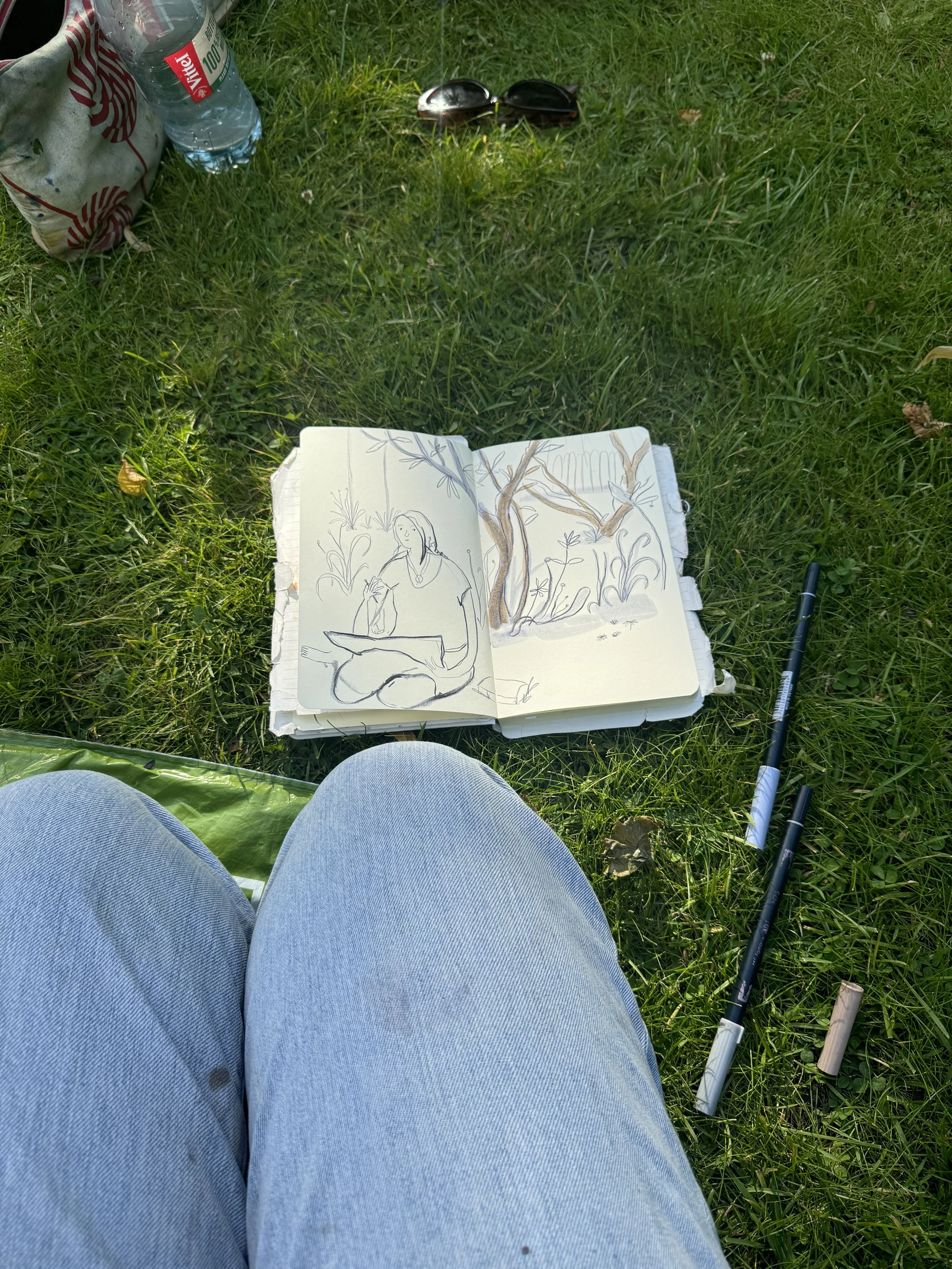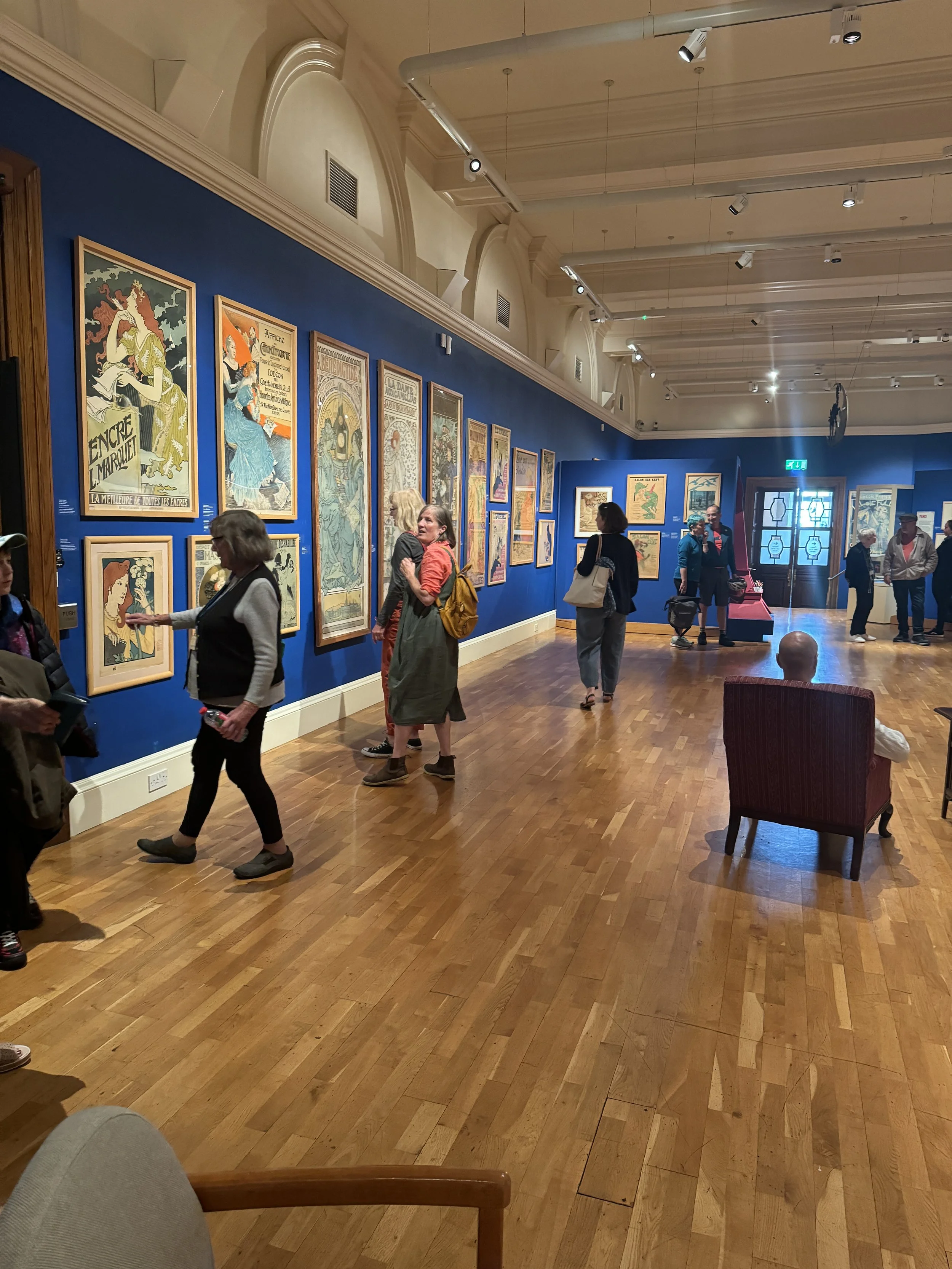July: Compasses, nets and ideas
Hi Everyone,
I hope you are OK! It feels like this month has gone by so quickly - I’ve spent lots of it catching up with friends, going out drawing and working on my final MA Projects behind the scenes. I’ve also been experimenting with a new crispy curried potato recipe that has turned out to be just the comfort food I’ve needed. I’ll leave it right at the bottom of this post.
Last month, I wrote a bit about burn out and creative block, I also talked a bit about nurturing the brain- making sure it’s ready for the new ideas to flow in. But after writing the blog post, I started to wonder about the next part - where ideas come from, and have been doing a bit of reflecting ever since. To be honest, I think it might have something to do with our final MA projects being due this December.
I did what I normally do when I’m thinking and made a big mind map. When I stood back from it, it seemed to be made up of three parts of the ideas process. These were, the compass - the bit that makes your interests yours, casting the net - the bit where you go out and explore, and reflecting, learning and growing - the bit where you look at it all and use what you’ve made to adjust your compass. In my mind, these three ideas all flow into each other, a bit like a cycle.
In this post, I'll briefly talk about what I mean by ‘personal compass’ and I’ll touch upon the reflecting and growing part, but what I really want to dig deeper into is the ‘casting the net’ bit - the bit where the initial seeds of ideas and interests can be explored. I’m really not any sort of expert in this, and I’m only sharing what I’ve learnt and am exploring in my own practise about the idea growing process.
Compass
I think what I mean by personal compass is really knowing what you like. Really knowing what you’re interested in. And this can change and grow and develop. I find that doing things like making mind-maps, writing thoughts down, spending time noticing what captures the attention is really helpful when I am feeling a bit lost or stuck. I think I can always tell if the thing that I’m making is something that I’m truly interested in, because I find the making so engrossing and all consuming. I always find a mind map really helpful. Or a list, whatever works for you, but circling back to what you like, what you’re interested in I think is always a good place to start, and to continue to revisit.
Casting the Net
This is the juicy part that I started thinking about when I started wondering about this blog post. It’s the part where, once you have an idea around what you would like to explore, you can lean into it and really soak up and enjoy the process. These are the things that have cropped up when you’ve been making your mind maps or lists. They could be themes, places, feelings or emotions, or subject matter. They can be really broad or very specific and I think that’s part of the beauty of it.
I know I used the term ‘casting the net’ but what I really mean is researching and filling up your creative cup with experiences that will help to feed ideas and grow your initial glimmers of interest or excitement. I think that the research part is where you find out whether you can take forward an interest into more of a project, and it’s also where the links between all the different areas that you’re interested in can be made. I’ve also noticed that this process is not always linear. Sometimes two or three ideas can be percolating all at once with all sorts of influences and interests connecting and growing together.
For me, a good place to start is thinking about places that connect with my interests. Are there any places to go and visit where you could draw? Are there any exhibitions that feel exciting, any plays or performances that could feed into your interests? Are there any podcasts that could be interesting, audiobooks, or TV shows? Are there any documentaries or films? Local places? Youtube videos or online classes, or courses? Are there friends who have similar interests that you could talk to?
I remember when I was researching my first project on my MA in Children’s Book Illustration, I was really interested in light, dark, performance, atmosphere and the feeling of anticipation. To ‘cast my net’ I went drawing at Bristol Festival of Light, where there were crowds and lots of contrasts between light and dark. I went to Wake the Tiger, which is a light based installation exhibition space in Bristol as well as theatre performances. I watched lots of Youtube videos of performers and performances, looked for themed life drawing sessions, and sat in my car to draw in Bath at night time.
The place that I always tend to start with is observational drawing. When I’m doing this, my brain is automatically focussing on what I am drawn to within a scene. I love the fact that when I’m out drawing with others, we will all be in the same place, but we will all be drawn to different elements of the scene. Observational drawing helps me to explore a place or an experience more fully too. After I’ve drawn in a place, I can remember the sounds, smells and feeling of the place in a more viseral way. After a while, your sketchbook becomes a bank of the places you’ve been but also of the things that interest you as well.
Exploring new places can also be really inspiring. When I first realised that a new place was a source of inspiration for me, I thought that it meant I would have to go to a new city or somewhere far away. I enjoy going to a completely new place, but it also can mean exploring a new route on the dog walk, or a new local place.
Another major source of inspiration for me are stories. I love stories in all forms and formats. I always have an audiobook on and love sharing book recommendations with my friends. But I also feel inspired by theatre, and plays, films, TV programs, documentaries, and stories that I overhear others telling each other when I’m out and about.
I think the most important thing to remember is that the net needs to be wide and varied. The diet needs to be broad and it needs to be directed by your own interests. I try and take myself out on an excursion once a week. This doesn’t always happen but I try and book into my diary an experience where I’m casting my imaginary net, or feeding my brain with something interesting for art purposes. Sometimes this looks like going to the theatre or going to a new town to draw. Other times this looks like listening to a history podcast or taking George on a new dog walking route. I think that the more I’ve been doing this, the more I’ve learnt that taking steps to feed my brain creatively helps me to feel as if I’m moving forward, especially when I’m in the midst of moments of creative block.
Reflecting, Learning and Growing
I think of this like sifting and distilling. Before my starting my MA, I didn’t really look through my sketchbooks. I loved drawing in them, but I didn’t feel the need to look back through and think about what I liked, what I didn’t like and what I wanted to move forward with. I think this has been a real game changer as it forces you to listen to your compass. It forces you to look back at drawings you didn’t like making and learn a little bit from them.
I also think that this process shouldn’t be limited to the art that we’ve made. I’ve been trying to think back at the books I’ve read, films I’ve watched and places I’ve visited - what was it about those places that I really liked and is there any part that I would like to carry forward either into the decision making around the next place that I go or the work that I make. This process feels a bit like treasure hunting to me.
If I could explain it simply
Make a list of all the things that you like, that interest you or you feel drawn too.
Make a new list of places, books, documentories, experiences, podcasts, ehabitions, TV programmes that link to your inital list, however tenuously this might be, and make an appointment with yourself.
Reflect. What are the things that hold your interest? What are the things you would like to know more about?
Repeat.
For me, this feels like it’s working at the moment, but I would really love to know if you have any processes that work for you when you are exploring new ideas!
Crispy curried potato recipe
However many small potatoes you think you can eat.
1 to 2 teaspoons of stock (depending on how many potatoes you’ve used).
1 to 2 tablespoons of curry powder, I use hot madrass but think it could be any that you like/ have in the cupboard.
1 teaspoon of turmeric powder (optional)
Chop potatoes into halves or quarters then part cook them in the microwave or on the hob. They need to be cooked enough so that you can squash them with the back of a fork.
In a big bowl mix all the spices and some olive oil with the potatoes - make sure they are covered with the mixture.
Tip potatoes into a tin baking tray and squash each potato with a fork so that they are almost flat.
Drizzle a bit ore olive oil over the top for good measure.
Put into the oven. We have a fan oven and put them in for 25 mins on 180 c.
If you’ve read this far and you’ve even read my potato recipe, thank you. Thank you so much for being here, it really does feel so nice to share these thoughts. I really hope that you have lovely months ahead and I’ll see you at the end of August!
L xx
This month on Patreon I’ve been sharing the materials I’ve been buying as well as some behind the scenes process videos. Each week I share what I’ve been up to and what I’ve been working on! I’m so enjoying sharing my work in this way and being able to share a few extra sneak peeks of my process with you.


















